there are 400 large underground sites in Egypt
In 1995I made a reconstruction of a Baghdad-type battery myself.My first try was a disaster: The reaction stopped after a few minutes. After some research I found the reason: Such natural acids which could have been used (I used vinegar) need air to react. Therefore the closed original constructions never could have worked as batteries!
In the television broadcastAliens do they return?byErich von Daeniken, already addressed by me in the pyramid section, he tried to make a connection between Baghdad batteries and light in his typical way. Hetried to suggest that a gas-discharge lamp could be powered with such a battery.So he connects a digital multi meter to the battery a loud buzzing noise suggests a high voltage. Then we can read a not defined voltage of 0293 on the meter; afterwards he presents a reconstruction of a Dendera-type gas discharge lampalso connected with a meter, and gives the impression that both voltages are of the same amount!
I must start with some words of warning. The book Lights of the Pharaohs by the Austrian authors Krassa & Habeck (they wrote the most popular summary of the thesis, and I base my discussion on it) is nicely written and sounds logically sound. After reading of the book a laymen might ask himself, why Egyptology publishes such a rubbish about Egyptian history, since it seems to be completely different.But anyone with just a slight knowledge about Egyptian history sees at once, what a load of rubbish is poured onto the trusting reader.Most parts of the history the authors unfold are free inventions, therefore I cannot discuss those parts of the book I simply have neither web space nor the time to correct everything they have twisted.I will stick therefore strictly to the objects and the technical and Egyptological discussions about them. Only some examples of Krassa/Habecks weird history will be discussed on an additional page at the end of this article.
17,400 tonsof this metal more precious than gold was needed.
So let us see how the representatives of the electro thesis interpret the famous Dendera picture.[1]Krassa/Habeck are giving the following explanations (which I will correct on the following pages )[2]
Dendera Lamp exhibit at theMystery Parkin Switzerland. It shows fringe (electric lamp) interpretation of the famous Egyptian relief from Dendera
All these batteries would have to lie around somewhere as scrap iron or waste. The find situation for batteries in Egypt is however ZERO!
After two pieces of circumstantial evidence have been eliminated we should now take a closer look at the objects themselves. I will start technical, since the authors of the thesis asked for it. On the following pages I will show what Egyptology says about the pictures.
BTW: It is possible to reduce soot from oil lamps by putting salt into the oil. I didnt try it out because I couldnt get soot even without salt in the oil
In contrast to the mainstream interpretation, there is a fringe hypothesis according to which the reliefs depict Ancient Egyptian electrical technology, based on comparison to similar modern devices (such as Geissler tubes, Crookes tubes, and arc lamps).
But the theory that electricity was known and used in antiquity seems to rest on a much more stable foundation. The key to the whole theory lies a few hundred kilometers east of Egypt, in todays Iraq. There some strange pots were found. Some contained watertight copper cylinders, glued into the opening with asphalt. In the middle of the cylinder was an iron rod, held in place also with asphalt. The excavator who found the first of these pots in 1936 was sure: this is a galvanic element, aprimitive battery[ seeBaghdad Batteryarticle] . Reconstructions did indeed show that it was possible to create electricity with it.
The second factor for a battery was solved nearly as inefficient than the first.
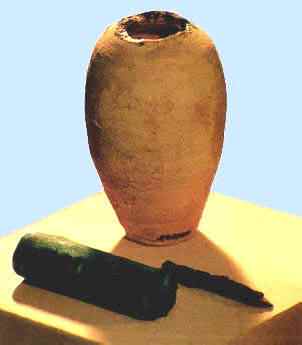
The book quotes from above have now been falsified twice.For one, many of the passages needed no artificial lighting, and second they also contain lots of soot.
This was my first lesson in how slow riddles are dying in alternative science. Because the first time I discussed this topic was even before I had connection to Usenet: in 1989!
Well, and where is the problem? you might ask. Simple. The problem is, thatthe working lamp picture in Dendera is only one of six.And from all six pictures this is the ONLY one where something reaches into the bulb!
From the Parthic, Babylonic or Egyptian region however no evidence for a systematic study of physics or chemistry, which is a mandatory prerequisite for the development of such technique is known.But without this knowledge no genius amateur handicraftsman can by coincidence invent something like a generator.This conclusion is therefore just as soundly as the reason chain They had wheels, therefore they knew a combustion engine.
Oh,after approximately 8 hours power output the inside of the battery decomposes into a green, poisonous mud which must be disposed of.
[2] Ercivan, Erdogan; Das Sternentor der Pyramiden, Bettendorf 1997, P. 83
There are surelydifferences between an accelerated galvanizing technique and lighting a light bulb.In the first case small amperages and voltages are enough to do the job, but not in the second case.Even a small torch bulb needs about one Watt to shed a dim light.
After I posted my results to the Maus I made first contact with the wide spread unwillingness in alternative science to accept unpleasant results.Bullsh*t, nonsense, I dont believe you, were the comments to my sootless lamps. I wrote back People, you mustnt believe me, just try it out for yourselves. Again I drew a blank: I dont need to try it out, I know what happens and its not what you are posting here was the only reaction.
It is a widespread belief in alternative science that our forefathers possessed a much greater technological knowledge than our schoolbook science is willing to accept. Many of those theories are lacking serious foundation and are often based on overdrawn speculations [ like theManna machine].
Its the same with the decorated chambers of the pyramids of the 5th and 6th dynasty. All decorations could be put to the wall blocks in broad daylight which were then covered afterwards. Even most of the private mastaba tombs could be finished with no artificial light.So missing soot in all these constructions would be no mystery at all.
The pictures of the objects can be seen three times in the subterranean crypts and three times in an associated cult room I will discuss later. The working lamp is once shown in the crypt. Three times pictures like this, with the air god Heh carrying the lamp are shown (one in the crypt, two in the cult room):
[5] Brunner-Traut, Emma; Alltag unter Pharaonen, Herder 1998, P. 245
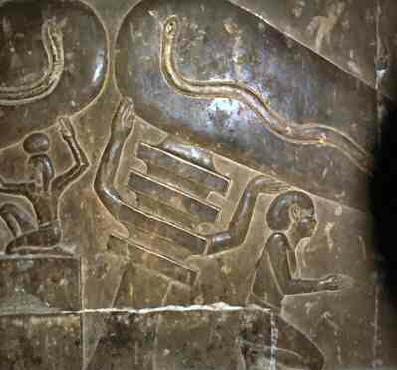
The only possible (and really used) explanation was: The Egyptians saw the whole thing just a short moment, so they couldnt remember how the thing really looked like. But you must admit that this is silly. As you remember: the core of the lamp-story is, that the Egyptians used those things centuries, even millennia, to routinely light out their pyramids and tombs. And yet they could not remember how their daily tool looked like?
But there are more problems demolishing even the basic idea that those things could be light bulbs of any kind. Krassa/Habeck seem to believe that the objects on the pictures are shown in their natural proportions with regard to
In the Roman and Greek world torches and oil lamps were used to light the buildings. Wherever places are left where such devices were positioned, we can find traces of soot on the walls and ceilings. But in ancient Egypt we can find these combustion traces nowhere.[2]
The passages and chambers in Egyptian pyramids were built with a few exceptions in open ditches like the example of Abu Roasch below. A large dugout was furnished with several layers of floor- and wall blocks, the sarcophagus was lowered into the open chamber, ornamented wall parts, finished outside, were lifted down and put in place, the roof was positioned, and then the ditch was refilled.The whole construction process took place in broad daylight.
In the temple of Hathor at Dendera, several dozens of kilometers
The great chambers of the red pyramid, and the passages in the great Pyramid, also were built in full daylight.The whole time, until the last ceiling block was positioned years after the chamber was begun, all tasks like polishing and furnishing the walls and roof beams could be done in daylight.Why should there be soot in such constructions?In the pyramid age only very few construction projects needed artificial light, like the Djoser-labyrinth and the underground passage and chamber in Khufus pyramid.
The source of the soot is pretty clear: almost all buildings have been opened in antiquity and were tourist attractions through the centuries, even millenia. For example: Greek writings were found in the subterran chamber of the Great Pyramid.There were thousands of visitors in them, and every single one of them, until the beginning of the 20th century, had to use oil lamps, candles or open flame torches to get light. And all those people spent a much larger amount of time in those buildings than the original builders.
When Volta experimented with its (by the way 10,000 times more efficient) batteries, he lived in the age of the research and progress. Each detail, each improvement was published and hundreds of scientists around the whole globe were busy with the study of nature and exchanged their results in innumerable publications. Nevertheless it lasted nearly 200 years until the induction was discovered, and out of this in the end the generator was developed. This needed an unbelievable number of small steps, and each of these can be reconstructed from uncounted publications.
Even the reduced model (which also contradicts the initial no-soot-evidence), that only priests hat this magical instrument and showed it a few times a year to the astonished masses, fails, because they had to have the objects at hand and could have copied them. If we take in account that the working model is dramatically outnumbered by the non-working types we can only conclude that the idea is, from the scientific viewpoint, flawed. In science an idea is only interesting if it can at least everything other ideas can explain, and it is really interesting if it can explain some things even better.
Dendera Soot on lamp relief
These small pots which were found in the proximity of todays Baghdad are thebest candidates for electro-chemical devices found so far
Well, if Daeniken was right, then all churches, houses and palaces before the invention of electric light must have been soot holes, because they all had candles or oil lamps as primary light sources. I hadnt noticed that, so there was a chance, that Daeniken was wrong.So I concluded that an experiment was necessary here.
Fact is, that the lamp explanation works only forone of sixlarge pictures, and fornoneof the uncountable snake stones in this temple and in all of Egypt.
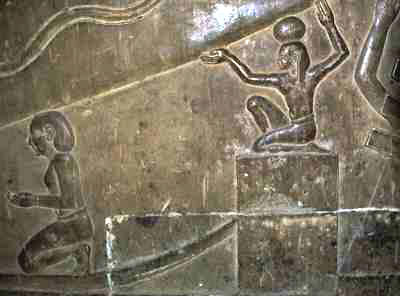
In thistemple in Dendera, several dozens of kilometers north of Luxor, some experts found the light. A Norwegian electrical engineer noticed that the object shown on the relief on top of this page could work as a lamp. An Austrian colleague was able to construct a working model, and two well known authors in the AAS, Peter Krassa and Rainer Habeck, could even work out a real theory based on it. What we see is without question a form of bulb, with two arms reaching into it near its thick end, and a sort of cable at the other end, from where a snake is leaping out to touch the arms on the other side.The whole ensemble really looks like a lamp.
After I drilled several holes into the cylinderit produced about 0.4-0.5 volts with open contacts, and had a short circuit amperage of 50 mA.The electrical performance adds up to 25 milli Watts without connected devices (which breaks down to1/10th with a single bulbattached).
[1] Däniken, Erich von; Die Augen der Sphinx, Ullstein 1989, P. 215
I took an ash tray, filled it with olive oil, formed a wick out of cotton wool, and soaked it with oil. Then I put the wick onto the side of the bowl so that it stuck out about 5 mm over the rim.I lit it and it produced a steady, smokeless flame. Only an extremely long wick lead to an emission of soot.
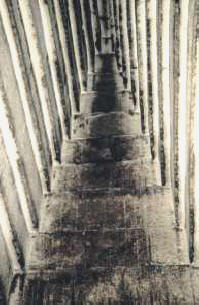
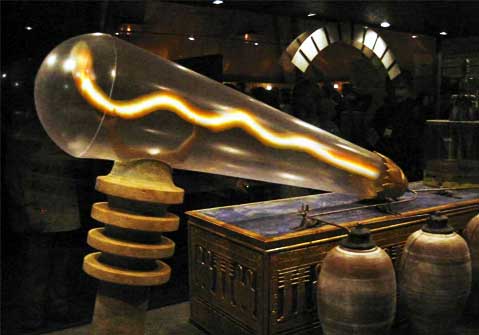
[4] Clarke, Somers & Engelbach, Reginald; Ancient Egyptian Masonry, London 1930, P. 201
The batteries found in Baghdad however are quite poor in comparison.Some contained only same metals(copper rods in copper cylinders) and can produce therefore no voltage at all. And those few who could contains the metal pairing copper/iron which are only 0.5 volts apart on the electro-chemical scale. This excludes any systematic research of the phenomenon which would be the basis for the development of a lamp.

Many visitors to the monuments express surprise that the painting could have been carried out in the darkness of the tombs and in the dim light of the temples. The Egyptian lamp was of the simplest type, merely a wick floating in oil. It is not infrequently represented in the scenes in the tombs, where it usually takes the form of an open receptacle mounted on a tall foot which, in the smaller examples, can be grasped in the hand. In the pictures, there arise from the receptacle what we may assume to be wicks or flames, always curved over the top as if blown by a current of air. Stand lamps in limestone have been found in the pyramid of El-Lahun, and representations of them in stone in the Labrinth at Hawara. In Egyptian houses, small dishes were also used as lamps. They usually have their rims pinched into a spout
This is the basis of the technical interpretation. Sounds logical, sounds comprehensible and doesnt work!
This chamber is completely above ground, built by Snofru, father of the builder of the Great Pyramid, Khufu.The soot seems to be millimeters thick,and if one goes through the pyramid passages in Egypt a look at the ceiling is enough tofind soot in abundance.
In the Egyptian temple of Hathor at Dendera, several dozens of kilometers
The performance of a battery is the product of voltage and amperage (volt times ampere). The voltage is a material constant between different metals. If we place two different metals in acid we can measure an electric difference measured i Volts. This difference is independent from the size of the plates, it only depends on the materials used. The difference between two plates of the same material is null. Therefore you can sort the various metals into an electro-chemical row with the most negative elements (giving up electrons) to the left and the most positive ones (collecting electrons) to the right. This principle is known to us for approximately 200 years, and the best combinations for metals are known almost as long.
Well, as Mr. Spock would say. Fascinating.None of the premises of the soot fans are correct.There is soot, although the Egyptian lamps were almost sootless and even buildings in no need of artificial illumination contain soot. This whole argument is as wrong as an argument can be. But just because we are sure that the soot comes from non-Egyptian sources it is still no evidence that can be used to propose alternative lighting methods.
J. N. Lockyers passing reference to a colleagues humorous suggestion that electric lamps would explain the absence of lampblack deposits in the tombs has sometimes been forwarded as an argument supporting this particular interpretation (another argument being made is the use of a system of reflective mirrors). Proponents of this interpretation have also used a text referring to high poles covered with copper plates to argue this but Dr. Bolko Stern has written in detail explaining why the copper covered tops of poles (which were lower than the associated pylons) do not relate to electricity or lightning, pointing out that no evidence of anything used to manipulate electricity had been found in Egypt and that this was a magical and not a technical installation. From Wikipedia

For the lighting of the building sites with batteries this means:
Well, but what IS funny:In all these buildings which did not need any artificial lighting, soot can be found.Even the walls of the crypts where those supposed light bulb reliefs were found are covered with soot, as this picture shows:
This is a picture with so-called snake stones. Krassa and Habeck are making fun about them, as silly explanations of Egyptologists therefore I will discuss their meaning on the Egyptological pages.
The view of Egyptologists is that the relief is a mythological depiction of a djed pillar and a lotus flower, spawning a snake within, representing aspects of Egyptian mythology. The Djed pillar is a symbol of stability which is also interpreted as the backbone of the god Osiris. In the carvings the four horizontal lines forming the capital of the djed are supplemented by human arms stretching out, as if the djed were a backbone. The arms hold up the snake within the lotus flower. The snakes coming from the lotus symbolize fertility, linked to the annual Nile flood.
Another key element for the electro-thesis is actually something that is missing.
= each system needed 292000 (!) batteries!
Well,I have been in Egypt several times now, and I never had a problem to detect soot in pyramids and tombs.As an example here the soot covered burial chamber walls of the Red Pyramid of Dahschur:

That means however, that for the operation of only one 1 watt-bulb the ridiculous quantity of forty batteries is needed! Since each battery weighs approximately 2 kilograms,the Egyptian flashlight without rack and wiring would weigh around 80 kilograms!
One 1 Watt bulb needs 40 batteries per working day.
north of Luxor, there are reliefs interpreted by some experts as lamps.
From these numbers it can easily be derived that the operation of electrical lamps with the so-called Baghdad batteries was simply impossible.But no other antique energy sources are known, so that any lamp faces the problem of a missing power source.
How so often in fringe science this lamp idea only works by omission of important details. You might have noticed that I emphasized the word two in Garns comment. Why? Because two is the key word. Every normal lamp needstwo electrodesto produce light, a simple light bulb or the Garn-construction.
There are more critical points about the lamp theory aside from the false argument of the missing soot. Another one:Where could have the Egyptians taken electricity from?For more than 200 years now systematic diggings took place in Egypt, and no electrical generators could be found. The only objects at all found from antique times which could produce some electricity are the famous Baghdad- Batteries.
[3] explained in in: Lauer, Jean-Phillipe; Das Geheimnis der Pyramiden, Herbig 1980, P. 37 f
= 116 million batteries were necessary
As long as no find for the development of such a technology is made, we must exclude it.Even when Krassa/Habeck declare theDjed pillarsurprisingly, after defining it in the first half of their book as electrical insulator, as a generator, which produces electricity with hot air and dust
Yes, and THAT is precisely the reason why the mystery of the soot is still part of every new publication and of at least one Mystery Park.
If we evacuate a glass bulb withtwometal parts reaching into it (B), (C), we can see a discharge at much lower levels, depending on the size of the glass balloon (D). At a pressure of about 40 t (tonnes) (40 mm of mercury) a snakelike light filament meanders from one metal part to the other (E). If we evacuate further, the light filament grows wider until it fills the whole glass balloon. This is exactly what we see in on the pictures in the subterranean chambers of the Hathor sanctuary.[3]
Right from the beginning the chief excavator Wilhelm Koenig had theopinion that these pots had been batteries used for galvanizing items. Some finds and writings led to the belief that the Parthians knew a method of coating copper or silver with gold by using gold cyanide without the use of electricity.With a reconstruction of the supposed battery the galvanizing rate could be quadrupled.
and two times this way with a djed pillar outside of the lamp (once in the crypt and once in the cult room):
The lamp model can not even explain five of the six large pictures, not to mention the hundreds of small snake stones. Funny: school science has no problems to explain them
Its a riddle where schoolbook science is capitulating.Soot.In none of the many thousands of subterranean tombs and pyramid shafts was found a single trace of soot, as we are told by the authors of the electro-thesis, although many of these tombs are full of often colourful paintings. But the primitive light sources the Egyptians knew (candles, oil lamps etc.) are always leaving soot and are using oxygen.So how DID the Egyptians get their light?Some rationalists are arguing withmirrors, but the quality of the copper plates the Egyptians used as mirrors were not good enough for that.
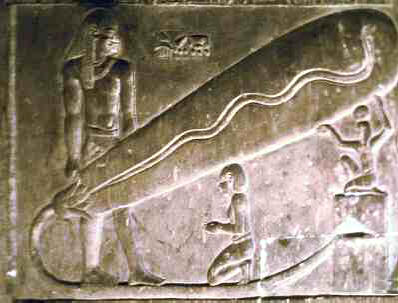
Krassa and Habeck are telling us, that torches, oil lamps or candles are emitting soot on a large scale, which must be detectable on walls and ceilings.But that is not the case.[1]

Before I go into the details of Dendera,I will examine some of the circumstantial evidence.Thats because some points several authors use to prepare the light mystery are in contrast to what I have seen personally. Here are two of many quotes:
Abu Roasch Trench for burial chamber
There is just another minor item always forgotten by the proponents of ancient batteries: The iron.Iron was a rare and precious metal in Egypt, because no ore is found there. The next iron ore deposits are in todays Turkey, and were in firm possession of the Hethites, which had a monopoly in manufacturing iron goods from around 1600 B.C. But each battery needed acentral iron rodas main electrode. So its simply impossible that a metal first used in 1600 b.C. played a major role in lighting pyramids built more than 1000 years before! Each battery contained about 150 grams of iron, so for the whole 400 big graves about
Each excavation took two years (veeeery carefully estimated)
These objects could never had been lamps. Neither a Garn-type nor a normal light bulb. But it gets even worse, because there are pictures of similar objects in the chapels around the temple. Without Djed, lotus or generator:
The Dendera light is a technology of electrical lighting supposedly in existence in ancient Egypt, proposed by some fringe authors. Proponents argue that the technology is depicted in the Hathor temple at the Dendera Temple complex located in Egypt on three stone reliefs (one single and a double representation), which resemble some modern electical lighting systems. Egyptologists reject the theory and explain the reliefs as a typical set of symbolic images from Egyptian mythology.
And even from the region where artificial light was most necessary we have notes from the Egyptians themselves: The many 100 m long tombs in the Valley of the Kings were definitively lighted with oil lamps and wicks, since we haveprotocols about wicks and lamps handed out to the workers each dayfrom the Valley of the Kings where it was carefully documented how many wicks of what length, and how much oil was given to each worker there is no mystery at all how these tombs were illuminated. There is no place for pharaonic flash lights.[ 5 ]
One of the major foundational arguments for the lamp idea has disappeared. We now see that that the no soot argument is definitively untrue, as even buildings which did not need light during construction time have soot in them. A bad situation which can even get worse Lets take a look at
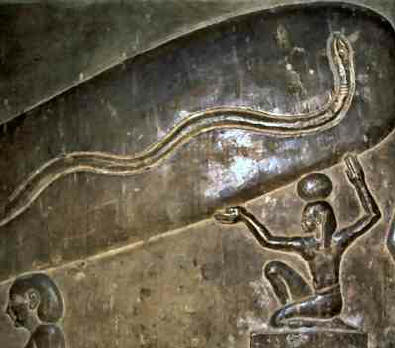
The oldest comment known to me aboutsoot in the Great Pyramid is from John Greaves, in a book from 1638!![ 3 ]
The oldest were found in a Parthi settlement, which was inhabited around the time of Christs birth. The discovery site a presumed hill which coincidentally was found to be an ancient village in 1936 suggests even a later settling. The other pots even might have to be settled into the period to 1200 CE. From this, any usage of such devices in ancient Egypt seems to be very improbable.
I hadnt written anything critical about Dendera or even Daeniken yet that was still five years in the future. But Daenikens new book In den Augen der Sphinx had just been published, and the passage I quoted on top of the page was discussed in one group of the so called Maus-Netz.
I put a white dish over the flame, about 50 cm high, but I was unable to detect any trace of soot even after a long time. And it was nice to find out after some years that even experts like the famous material experts Clarke/Engelbach shared my opinion:
The amperage depends on the surface of the used electrodes. An ideal battery possesses two electrodes with surfaces as large as possible, with materials lying apart as far as possible on the electro-chemical scale. For example disk batteries like the famous Volta pile, which consisted of copper and zinc plates. Or our zinc coal batteries, whose central electrode is an activated charcoal staff with an active surface as large as several football fields. The relics of Baghdad are there poor, too, they came with single rods of iron with a minimal surface as counter electrode. This is another argument against coming from a systematic research of electricity.
10 workers were digging out each site
If the Egyptians already knew batteries, then different generators will probably have been known is a merry, but absurd or missing way of proving a theory.
Such devices were only useable once. If they were used in large numbers in daily life, remnants of them must have been found somewhere. This is known to the proponents of this idea, too, so they strip down the usage of electric light to sacral purposes only. The situation gets schizophrenic here: On one hand the author shows a problem (soot) which only could be solved (in their opinion) by massive use of electric lighting, on the other hand they reduce their theory to a small scale sacral use themselves. Their own theory therefore can not solve the problem created to initiate the idea!
And the soldering on the bottom gave way, too, so that the whole mess fell into the cylinder I had placed below the metal cylinder.
== With a total weight of 233,600 tons!

In his book The Eyes of the Sphinx pp. 171-173, Erich Von Däniken writes that the relief is found in a secret crypt that can be accessed only through a small opening. The room has a low ceiling. The air is stale and laced with the smell of dried urine from the guards who occasionally use it as a urinal. The room is not so secret, however, as many tourists visit and photograph the room every year. Von Däniken sees the snake as a filament, the djed pillar as an insulator, and claims that the monkey with the sharpened knives symbolizes the danger that awaits those who do not understand the device. This device is, the reader is assured, an ancient electric light bulb.
The absence of smoke-blackening in the tombs of the kings is also no difficult explanation. If olive-oil is used, there is very little smoke, and a suitable covering over the lamp, for which various methods readily suggest themselves, would very easily prevent carbon being deposited on the ceiling.[ 4 ]
Another picture from the crypts of Dendera: Eastern relief on south wall
On the basis of this picture engineer W. Garn constructed a working device which indeed gave some light. In the book of Krassa/Habeck we find he following sketch and description:
The original white color of the lime stone can be seen on the edges of the re-set block
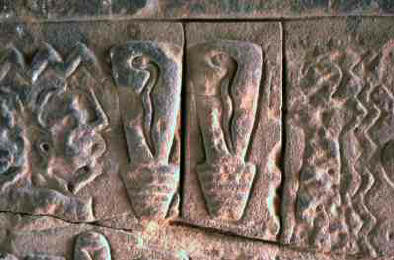
north of Luxor, there are reliefs interpreted by some experts as electric lamps.